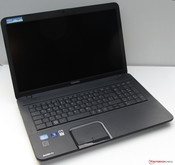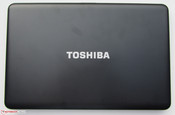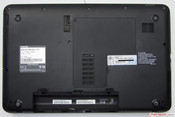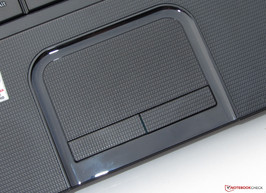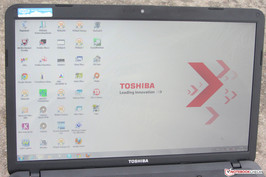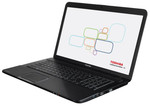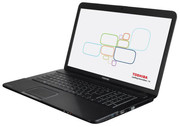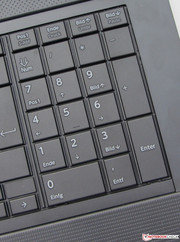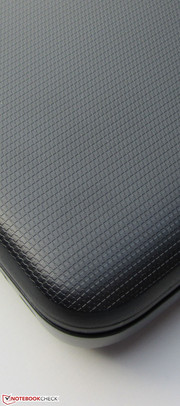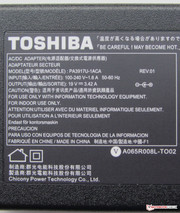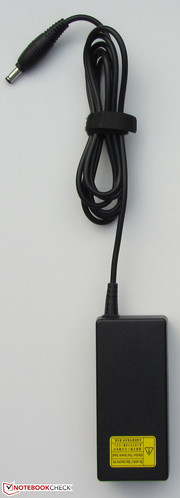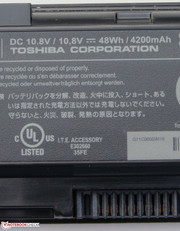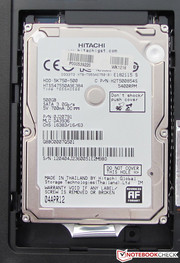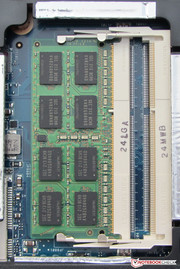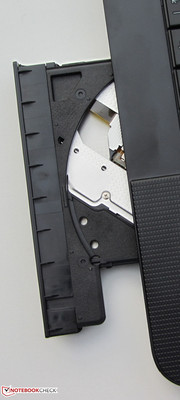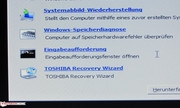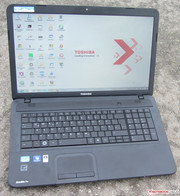Review Toshiba Satellite Pro C870 Notebook

The Toshiba Satellite Pro C870 series is comprised of 17.3-inch notebooks for the business environment in the low-to-mid price range. About two years ago, we reviewed a precursor to the series, the Toshiba Satellite Pro L670-170. The Satellite Pro C870-11R notebook we have been provided to review, at about 500 Euros (~$637), is currently the cheapest model in this series. The device is powered by an Intel Core i3-2350M dual-core processor, and has four gigabytes of memory to work with. The Intel HD Graphics 3000 is responsible for the graphic display; a 500 GB hard drive serves as the data storage unit; and a DVD-burner is also at your disposal.
To judge the comparative quality of the notebook, we will put the competing Acer Aspire 7739Z-P624650MNKK (Intel Pentium P6200, Intel GMA HD) and Samsung Series 3 305E7A-S03DE (AMD A6-3420M, AMD Radeon HD 6540G2) onto the field.
Case
The Toshiba Satellite Pro C870 can't deny its familial ties to the Toshiba Satellite Pro L670-170. The case is completely made of matte-black plastic. A shiny plastic ring surrounding the touchpad is the only exception. The backside of the lid, the palm rest and the touchpad all have ribbed surfaces. Thanks to this surface design, the case hardly shows any fingerprints and is also very easy to grip. Visually the case is clearly tending towards the austere, which again underlines its claim to be a work computer. The Samsung Series 3 and the Acer Aspire are similarly outfitted with purely plastic cases.
The base unit gives an impression of general stability and hardly yields when pressure is applied. It does have one weakness, however: the edge over the disk drive is quite unstable and gives fairly easily. The lid of the notebook can be bent using little force, and the backside of the lid also gives easily. The hinges hold the lid tightly in place and rock back-and-forth a little. It is not possible to open the notebook using just one hand; the hinges are too tightly adjusted for that.
Connectivity
In terms of connections, the Satellite Pro C870 is almost exactly like its predecessor, the Toshiba Satellite Pro L670-170. The one difference: One of the three USB ports has been upgraded to a USB 3.0 port. The Acer Aspire 7739Z and the Samsung Series 3 305E7A-S03DE match the C870 in both number and type of connections, except that neither of the two other notebooks possesses a USB 3.0 port.
Communication
The WLAN module on the Satellite Pro C870-11R is equipped with a chip from the company Realtek (RTL8723EA). It supports the WLAN standards 802.11 b/g/n. The Bluetooth 4.0 functionality is also provided by the WLAN module. For wired networks, too, Toshiba puts its confidence in Realtek and furnishes its notebook with a Gigabit Ethernet Chip from the RTL8168/8111 family. A built-in webcam makes participation in video conferences and video calls possible. Toshiba preinstalled the Skype software as well.
Accessories
As far as accessories go, you'll find the usual in the box: a quick start guide and manuals. A driver DVD is not included.
Operating System
The Satellite Pro C870 is delivered with Windows 7 Home Premium (64-bit) preinstalled. A Windows 7 DVD does not come with the device. If you would like to be able to claim a Windows 7 DVD as your own (for example, in order to reinstall it after switching out the hard drive), you can learn from one of our news articles how to create such a DVD yourself.
Toshiba Recovery
For system restoration, Toshiba includes a recovery partition. Toshiba integrated the recovery software in Windows 7's system repair functions. To bring it up, after turning on the notebook all one need do is press the F8-key. The "Advanced startup options" menu appears. Here one simply selects the option "Repair computer". But be careful: The computer is reset to its default settings. All user-created or user-installed data and programs are mercilessly deleted.
Preinstalled Windows Frustration
The C870's Windows system didn't make us very happy. Something or other went wrong on Toshiba's side of the configuration. Our test programs often required a system reboot to install. Furthermore, the system is clogged with a lot of Toshiba's own software. We recommend every user to install a clean Windows 7 system directly after purchasing the device. But be careful: The notebook's included programs and the recovery system will then be lost and no longer usable.
Maintenance
On the under-side of the Toshiba computer you'll find a maintenance hatch, behind which the memory, hard drive and BIOS battery are hidden. There is no access point to the fans. The Satellite Pro C870 contains two memory banks. Our test model is equipped with a 4 GB module; an upgrade up to 8 GB would be possible. An additional 4 GB module currently costs between 15 and 20 Euros (~$19 and $25). A hard drive exchange could be done quickly and easily.
Warranty
Toshiba provides the Satellite Pro along with a 12-month Collect & Return Warranty. In a warranty case, the device would be collected from the customer and brought back to him afterwards. In this the Acer Aspire 7739Z and the Samsung Series 3 305E7A-S03DE offer more: Both 17-inchers are outfitted with a 24-month warranty. However, Toshiba offers many warranty extensions for the C870. A four-year on-site warranty can be purchased at about 160 Euros (~$204); a three-year Collect & Return Warranty would cost the user about 70 Euros (~$89).
Input Devices
Keyboard
The C870's keyboard parallels the keyboard on the Toshiba Satellite Pro L670-170 in both form and function. There is a number block. The main keys have a surface of 15 x 17 mm (0.59 x 0.67 inches) and thus are adequately dimensioned. The arrow keys as well as the Enter key could be bigger. The arrow keys feel a little squeezed in. The keys have a short stroke distance, and the stroke itself is not very perceptible. The latter is less the fault of the keys, and more the fault of the keyboard as a whole. It yields even to soft touches and doesn't sit tightly in its casing. The Samsung Series 3 305E7A-S03DE offers a distinctly higher-quality keyboard.
Touchpad
The C870's Synaptics touchpad is measured at 8.6 x 4.6 cm (3.4 x 1.8 inches). The touchpad could have been bigger; there would have been more than enough room. The touchpad is encircled by a shiny plastic ring that is much too wide: it doesn't suit the notebook, visually speaking. The touchpad has the same ribbed surface as the palm rest. This surface does not hinder the finger from gliding. The pad has multi-touch capabilities. The diverse multi-touch gestures can be turned on and off separately in the configuration menu. Two mouse keys sit underneath the pad; these have a short stroke distance and a clear action point.
Display
Toshiba furnishes the C870 with a matte 17.3-inch display that works with a native resolution of 1,600x900 pixels. Toshiba does not offer other display types for the C870. The Samsung Series 3 305E7A-S03DE and the Acer Aspire 7739Z displays have the same resolution. Out of the two competitors, only the Samsung notebook possesses a matte display. The average brightness of the C870 display lies in a good range at 235.4 cd/m². The Acer notebook (231.3 cd/m²) lies at the level of the C870, the Samsung device lies at 211 cd/m² somewhat behind.
| |||||||||||||||||||||||||
Brightness Distribution: 87 %
Center on Battery: 235 cd/m²
Contrast: 362:1 (Black: 0.65 cd/m²)
53.8% AdobeRGB 1998 (Argyll 3D)
75.8% sRGB (Argyll 3D)
52.3% Display P3 (Argyll 3D)
In terms of black value and contrast, the Satellite Pro C780 clearly distances itself from the competitors. The black value of the C870 display lies at 0.65 cd/m² in the upper-mid range. The contrast value lies at 362:1 in the area of the acceptable. The competitors Acer (1.2 cd/m², 198:1) and Samsung (1.87 cd/m², 118:1) can't compare with the Toshiba notebook. The sRGB and the AdobeRGB color space cannot be displayed on this device.
A maximum brightness of 235 cd/m² in battery mode makes use outdoors possible. The matte surface of the display makes this task even easier, since the user is generally spared from reflections.
In the area of visual angle, the C870's display is resigned to the usual cost of inexpensive notebooks: a change of the vertical visual angle quickly leads to a break in the picture. The horizontal visual angle shows itself to be measured a little more generously.
Performance
With the Satellite Pro C870 series, Toshiba offers a line of simple and inexpensive 17.3-inch notebooks for the business arena. It is also suitable, however, for private users who are looking for a cheap DTR notebook. The device offers sufficient performance for daily computer activities. The Toshiba website currently lists four models for the C870 line. The models differentiate themselves in processors and hard drives. Our test device represents the most inexpensive model in the series and is currently available for around 500 Euros (~$637).
Processor
Toshiba furnishes the Satellite Pro C870-11R with an Intel Core i3-2350M dual-core processor. This CPU originates from Intel's Sandy Bridge processor generation and works at a speed of 2.3 GHz. There is no Turbo Boost.
The CPU completes the Cinebench test with good speed; consequently the results lie in the expected high range. As can be seen the C870 clearly possesses the strongest CPU. In the GL benchmarks, the Samsung Series 3 305E7A-S03DE (AMD A6-3420M, AMD Radeon HD 6540G2) is a clear winner, since the Samsung device contains two Radeon graphics cards with much greater performance abilities. The Acer Aspire 7739Z-P624650MNKK (Intel Pentium P6200, Intel GMA HD) lies behind the C870 in every test.
System Performance
The system could run more quickly and fluidly. Overall, the 17-incher is slowed by its hard drive. The results of the PCMark Vantage benchmark lie in the expected range and around the same level of other notebooks equipped with an Intel Core i3-2350M processor - for example the HP ProBook 4530s-B0Y11EA. The results for the Samsung notebook (AMD A6-3420M, AMD Radeon HD 6540G2) is around the same range as the Toshiba model. The Acer Aspire (Intel Pentium P6200, Intel GMA HD) lags behind both.
| PCMark Vantage Result | 4848 points | |
Help | ||
| PCMark Vantage - 1024x768 Result (sort by value) | |
| Toshiba Satellite Pro C870-11R | |
| Acer Aspire 7739Z-P624650MNKK | |
| Samsung 305E7A-S03DE | |
| Toshiba Satellite Pro L670-170 | |
Storage Devices
Our test notebook is outfitted with a Hitachi hard drive from the Travelstar 5K750 series. The hard drive has a storage capacity of 500 GB and works at a speed of 5,400 revolutions per minute. The hard drive doesn't exactly set a record for speed. CrystalDiskMark measures it at a read speed of 73.84 MB/s. HD Tune records an average transfer rate of 60.2 MB/s. With that score, the hard drive lies in the low-mid range for 5,400 RPM hard drives. Anyone who doesn't need a ton of storage space should replace the hard drive with a Solid State Drive. The difference will be immediately obvious.
Graphics Card
Like the CPU, the GPU also comes from Intel. The Intel HD Graphics 3000 GPU operates at a speed of 650 to 1,150 MHz and supports DirectX 10.1. The results of the 3D Mark benchmarks lie in the expected range. Against the concentrated power of the two Radeon GPUs in the Samsung Series 3 305E7A-S03DE (AMD A6-3420M, AMD Radeon HD 6540G2) the Toshiba notebook doesn't stand a chance. The Acer Aspire 7739Z-P624650MNKK (Intel Pentium P6200, Intel GMA HD) can't stand up to either of its competitors.
| 3DMark 03 Standard | 7766 points | |
| 3DMark 05 Standard | 6003 points | |
| 3DMark 06 Standard Score | 3169 points | |
| 3DMark Vantage P Result | 1612 points | |
Help | ||
Gaming Performance
The Satellite Pro C870 presents itself first and foremost as a work device. Anyone who wants to play elaborate 3D games is looking in the wrong place. The C870 produces fluid frame rates only at low resolutions and even then at low quality. However, things don't look so bad if you want to play games that demand less of the hardware, for example the FIFA series.
| low | med. | high | ultra | |
|---|---|---|---|---|
| Fifa 13 (2012) | 91.8 | 39.43 | 20.32 |
Emissions
Sound Emissions
In idle mode the C780 works rather quietly. We measured the emission volume at between 33.1 and 33.3 dB(A). If you use the DVD drive, the volume goes up to 37.5 dB(A). Running at full capacity (with Prime95 and FurMark running), the volume rises to 40.8 dB(A). At half capacity (3D Mark 06 running), with a volume of 38.2 dB(A) the computer runs only a little more quietly. Anyone who is looking for as quiet a notebook as possible should take a look at the Samsung Series 3 305E7A-S03DE and the Acer Aspire 7739Z: Both notebooks produce less noise than the Toshiba device at every load level.
Noise level
| Idle |
| 33.1 / 33.3 / 33.3 dB(A) |
| HDD |
| 33.8 dB(A) |
| DVD |
| 37.5 / dB(A) |
| Load |
| 38.2 / 40.8 dB(A) |
 | ||
30 dB silent 40 dB(A) audible 50 dB(A) loud |
||
min: | ||
Temperature
Toshiba has a handle on the heat generation of the Satellite Pro C780. In idle mode the 17-incher reaches between 23.3 and 34.7 degrees Celsius (~74 and 94.5 °F) both on the top and bottom of the device. Running at full capacity (Prime 95 and FurMark working simultaneously) the temperatures rise to between 24 and 37.6 degrees Celsius (~75 and ~100 °F). In both instances you could lay the notebook on your lap without a problem. The palm rest is also a comfortable work surface, since its temperature never exceeds the 30 degrees Celsius (86 °F) mark.
Both the CPU and the GPU constantly work at full speed both in the battery and AC modes during the stress tests (Prime95 and FurMark working simultaneously for at least an hour). We did not detect any throttling. The CPU temperature levels off at around 67 degrees Celsius (152.6 °F) during the tests.
(+) The maximum temperature on the upper side is 34.7 °C / 94 F, compared to the average of 34.3 °C / 94 F, ranging from 21.2 to 62.5 °C for the class Office.
(+) The bottom heats up to a maximum of 37.6 °C / 100 F, compared to the average of 36.8 °C / 98 F
(+) In idle usage, the average temperature for the upper side is 27.7 °C / 82 F, compared to the device average of 29.5 °C / 85 F.
(+) The palmrests and touchpad are reaching skin temperature as a maximum (32.5 °C / 90.5 F) and are therefore not hot.
(-) The average temperature of the palmrest area of similar devices was 27.6 °C / 81.7 F (-4.9 °C / -8.8 F).
Speakers
The stereo speakers on the Satellite Pro are located above the keyboard behind a perforated plastic covering. The speakers produce a very thin, slightly tinny tone. Watching a movie with these speakers would not be much fun. A better sound experience would be possible with headphones or external speakers.
Battery Life
Power Consumption
In idle mode we read a power draw of between 8.2 and 14.8 Watts. With that result the C870 lies on average at the same level as the Samsung Series 3 305E7A-S03DE. The Acer Aspire 7739Z reveals itself to be a good bit hungrier and indulges itself in a power consumption rate of 11.3 to 20.4 Watts. At full capacity (Prime95 and FurMark running simultaneously) the power consumption rates of both the C870 and the Acer device rise to 53.3 Watts. The Samsung model reaches a value here of 56.1 Watts. At half capacity (3D Mark 06 running), the C870 needs 41.4 Watts: exactly 2.1 Watts more than the Samsung notebook and 6.5 Watts more than the Acer notebook.
| Off / Standby | |
| Idle | |
| Load |
|
Key:
min: | |
Battery Life
With the notebook in idle mode, the C870's battery holds out 6:15 hrs (Samsung 5:26 hrs, Acer 4:30 hrs). The idle mode is checked with the help of the Battery Eater Reader’s test - with the screen running at minimum brightness, the energy-saving profile activated, and the wireless module turned off. In load mode the Satellite Pro reaches a runtime of 1:16 hrs. The Samsung battery dies out five minutes earlier. For the load analysis the Battery Eater Classic test runs on the notebook - here the screen glows at full brightness, and both the high performance profile and the wireless module are activated.
On the C870 the WLAN test reaches a runtime of 3:53 hrs (Samsung: 3:27, Acer: 1:32 hrs). During this test websites are automatically loaded at 40-second intervals. The energy-saving profile is active and the display brightness is set to about 150 cd/m². In the DVD test, the Satellite Pro C870 makes it to a runtime of 2:58 hrs (Samsung: 2:24 hrs). In this test the wireless module is turned off, the display works at full brightness and either the energy-saving profile or a higher profile (if the DVD doesn't play fluidly) is used.
The runtimes of the three competitors are relatively easy to compare, since they all have one battery with a storage capacity of 48 Wh at their disposal. Without a doubt, the Toshiba device reaches the best battery run times.
Verdict
The Toshiba Satellite Pro can be recommended solely for the office. It offers more than enough performance capability for all common usage scenarios and provides a large, satisfying display. This recommendation is restricted to office use due to dissatisfaction with the keyboard. Prolific writers would be rather unhappy with the C870's keyboard and should look to the Samsung Series 3 305E7A-S03DE instead. Anyone who seldom or never writes long texts would be able to live with the keyboard. The Acer Aspire 7739Z-P624650MNKK is recommendable only if price is the main criterion in choosing a notebook. The Acer notebook is currently available in the Acer Aspire 7739 (without a "Z" at the end) variant for about 400 Euros (~$509).




